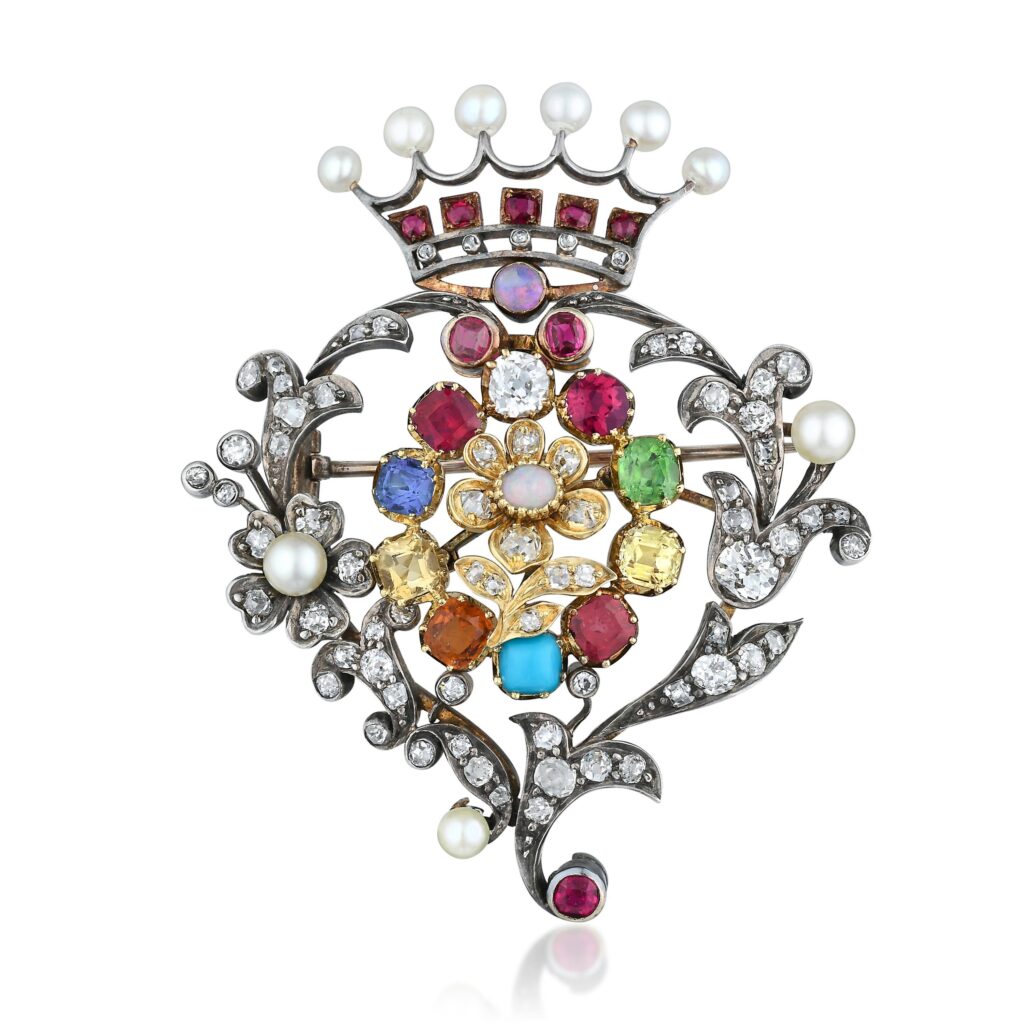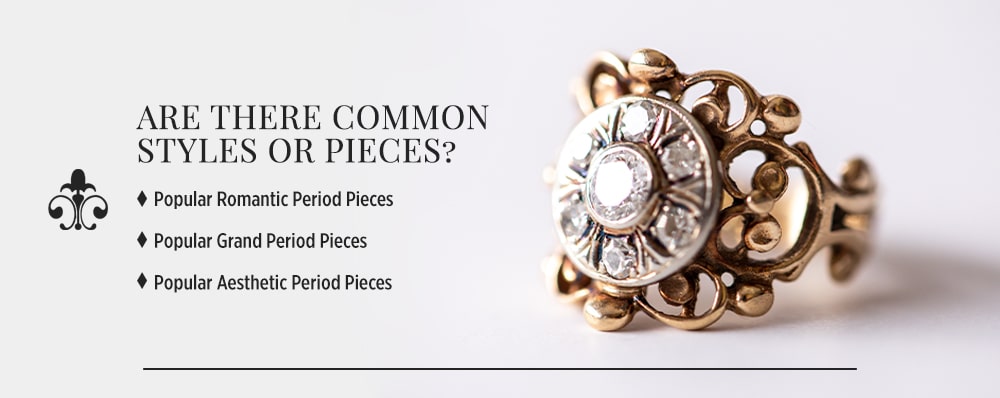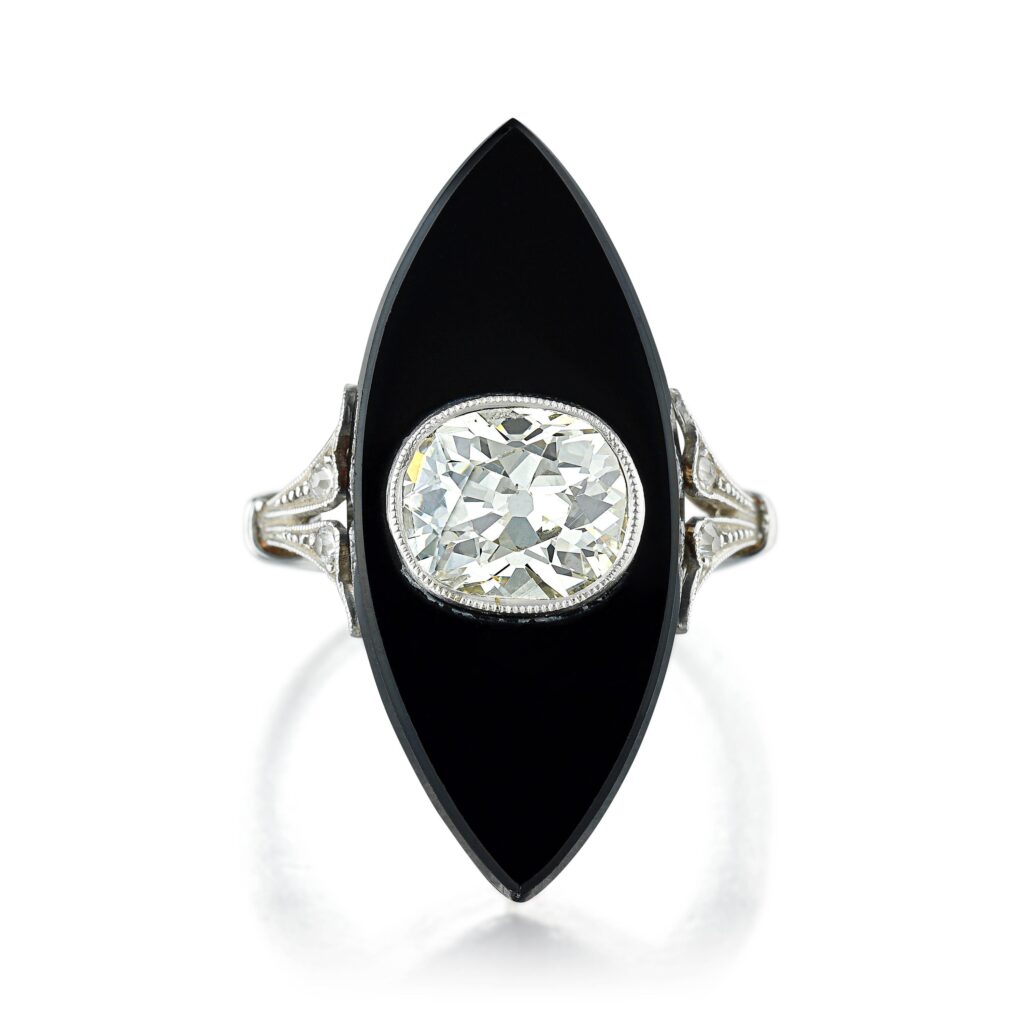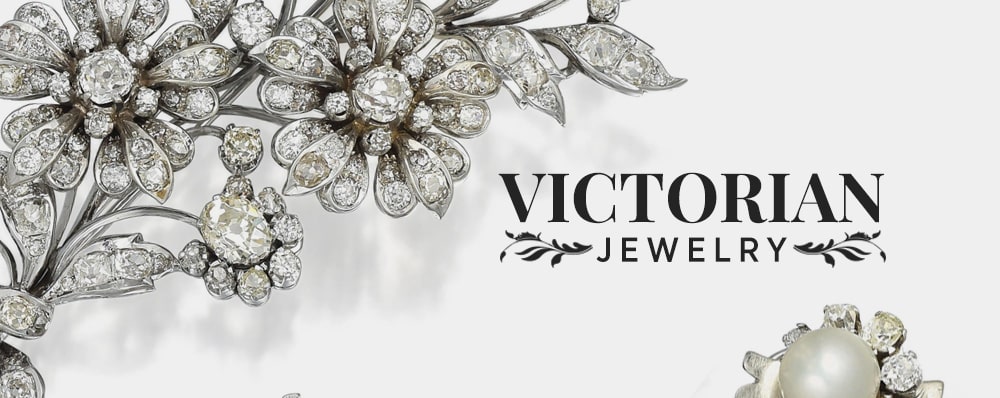The Victorian era lasted from about 1837 to 1901 and was named for Queen Victoria of England. During her reign, Queen Victoria had a dramatic influence on style and fashion, including jewelry.
What Is the History of Victorian Jewelry?
The Victorian era is divided into three distinct periods — Romantic, Grand and Aesthetic — each representing unique eras of the Queen’s life and society’s evolving values. Learn more about Victorian era jewelry and how to identify it.

Sold for $1,063
The Romantic Period
During the Romantic period, ancient mythology inspired intricate goldwork. Decorative hair combs and pins were popular, along with Christian cross pendants and personalized lockets. This period got its start when Prince Albert proposed marriage to Queen Victoria with a serpent-shaped, bejeweled engagement ring.
The golden serpent represented the Roman symbol for eternal love. It featured a diamond mouth, ruby eyes and a prominent emerald for Victoria’s birthstone. Engagement rings incorporating the bride’s birthstone became popular as a result. Since society valued modesty for women, high necklines and bonnets made necklaces and earrings unpopular. But rings were large, colorful and full of jewels.
The Grand Period
The Grand period was a season of mourning. In Victorian times, mourning was a strict, lengthy process. When a family member or spouse passed away, the griever had to wear a full black wardrobe. As a result, an entire industry formed around producing mourning clothing and jewelry.
At the passing of Prince Albert in 1861, Queen Victoria’s wardrobe of mourning influenced fashion. The following Grand period included pieces of jet, onyx and black glass. Some pieces included human hair or a likeness of the deceased. Skulls and skeletons were also popular.
The Aesthetic Period
Attitudes lightened again during the Aesthetic period of the 1880s. During this period, there was a renewed appreciation for handmade artwork, rather than manufactured. Jewelers focused on showcasing the visual appeal of gems. Wearing jewelry became less about flaunting wealth — pieces grew smaller and daintier. Women also preferred smaller pieces due to their increasingly active lifestyles. In general, the focus shifted to artistic craftsmanship.

Are There Common Styles or Pieces?
Each period came with “hot” items, appealing to a broad market. Since the three periods were so differentiated, it’s best to consider each on its own.
Popular Romantic Period Pieces
This period was all about expressing affection in close relationships. One popular way to do so was with a “regard” ring, spelled out with corresponding gemstones. For instance, a “regard” ring would have a row of gems in the order of ruby, emerald, garnet, amethyst, ruby and diamond. That way, the gems “spelled” the word “regard” across the ring. Other rings used gems to spell words such as “adore,” “dearest” and “forever.”
Popular Grand Period Pieces
The most intriguing and distinct jewels from this period were pieces incorporating human hair. Queen Victoria herself wore a locket of Prince Albert’s hair. Hair-woven pieces became a popular way to signify mourning. Whether they contained hair or gems, pieces tended to be large and heavy, representing the extravagance of the uber-wealthy. Of course, materials were often black in color to signify mourning.
Popular Aesthetic Period Pieces
Motifs during the Aesthetic period were nature-inspired, including owls, clovers, oak leaves and stars. Pieces tended to be smaller and daintier. Though industrial mass-production was available, many jewelry-enthusiasts preferred hand-worked and hand-stamped pieces. One popular trend was to include the Hebrew word “Mizpah” on jewelry, meaning “the Lord watches over us while we’re apart.”
Who Are Some of the Most Major Jewelry Influencers of the Period?
Of course, Queen Victoria herself set global trends. Fashion tended to represent the Queen’s eras of life and values — romance, mourning and turning toward a brighter future. The master jewelers of the time helped fortify the trends and produce pieces for consumption.
Some of the most influential jewelers of the 19th century included Carlo Guiliano and Alessandro Castellani. Guiliano was a goldsmith who worked with several prominent London jewelers. Guiliano was an Italian and moved to London with his family in 1860. Castellani, who was also Italian, worked alongside archeologists to recreate ancient jewelry styles. The two of them created many famous Victorian-era pieces.

Sold for $5,625
How Can You Identify Victorian Jewelry?
Because Victorian jewelry is so diverse, it can be tricky to identify. Certain clues may help you determine if a piece is Victorian. Evaluate these elements to decide whether or not you have a piece of Victorian jewelry:
- Fittings and clasps.
- Materials.
- Motifs and symbols.
Fittings and Clasps
Jewelry made in the 19th century was limited to certain hardware — some clasp and fitting technologies were not invented until the 20th century. For instance, early brooch fasteners from around 1850 had a tube hinge and simple C-shaped catch. In the 1910s, safety catches emerged. If a brooch features a safety catch, it’s unlikely to be Victorian.
Materials
During the Romantic period, gold dominated along with precious gems. Gold remained popular during the Grand period, along with darker materials like black enamel, jet and onyx to symbolize mourning. Newly discovered diamonds became a common element of Aesthetic period jewelry. To determine if a piece of jewelry is Victorian, evaluate whether or not its materials match the trends of the time.
Motifs and Symbols
Dramatic changes in common symbols and motifs marked each period of the Victorian era. Note the main influences on each period:
- Romantic: The Romantic period involved many references to ancient Greek and Roman mythology. You may find depictions of figures like Cupid or Aphrodite.
- Grand: During the Grand period, bulky pieces might incorporate human hair or depictions of the dead, as well as symbols of skulls and skeletons. Archeological finds kept ancient influences popular.
- Aesthetic: Pieces from the Aesthetic movement tended to be small and include nature-inspired imagery. Stars, moons, animals and leaves were common.
Buy or Sell Jewelry With FORTUNA
Antique jewelry pieces are physical relics of history — their value increases with their historical significance. The intrinsic worth of materials and craftsmanship is not the only factor that makes jewelry valuable. Jewelry tells age-old stories of love, grief and optimism.
Determining the value of jewelry can be a tricky pursuit. Sellers often have no way of knowing whether or not valuations are fair, and buyers can fall victim to inflated prices. That’s why real-time, transparent auctions are so popular among jewelry traders. If you’re looking to buy or sell jewelry, check out upcoming auction. With FORTUNA, jewelry sellers earn more as competitive bidding creates a fair price.

